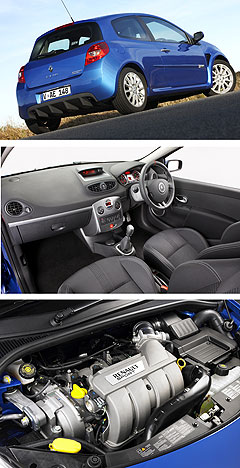Make / Model Search
New models - Renault - Clio - Renault Sport 197 3-dr hatchFirst drive: Renault Sport Clio 197 is one hot hatchHatched: Hottest version of MkIII Clio joins second-gen Clio Campus on sale. Renault’s long-awaited RS Clio 197 is set to stir hot-hatch lovers8 Aug 2008 RENAULT’S ballistic baby is back on sale in Australia after almost two years away. The X85-series Clio III Renault Sport (RS) 197 introduces the French company’s third-generation B-segment light car to Australia, three years after its European unveiling. It joins the single variant of the previous-generation X65-series Clio, which arrived here in July 2006, on sale in Australia. Priced from $36,490, the three-door-only Clio RS is $4000 more than the old Clio MkII RS 182, but still undercuts the equally iconic Mini Cooper S by $3410 and Honda's Civic Type R by $3500. However, Renault has also cast its newcomer across some larger small-car hot-hatch combatants such as the $34,990 Holden Astra SRi Turbo and (five-door) $36,990 Ford Focus XR5 Turbo, while the Clio RS is only $2000 cheaper than the Volkswagen Golf GTI and just $1000 shy of its Megane RS 225 big brother. Of the more traditional light-car hot-hatches, the Renault is $3000, $6500, $9500 and $11,500 more than the Peugeot 207 GTi, Mitsubishi Colt Ralliart, VW Polo GTI and Ford Fiesta XR4 respectively. Yet only the Civic and Fiesta match the Renault in not being turbocharged, while the Clio is significantly larger in every dimension than its respected predecessor. For instance, the gap in length between Clio II and III is around 200mm, while the same amount also applies between the latter and the Megane. The upshot, though, is a hefty weight jump: 1240kg versus 1035kg for the old car. Compared to the regular Clio III, the RS’ body has been pumped up with wider front and rear wings to accommodate the larger wheels and tyres, side skirts and a semi-rigid under-bumper splitter, while the stance has been lowered.  Extractor vents and an active rear air diffuser have been devised to aid stability and prevent rear-end lift by creating a zone of low pressure beneath the car in order to achieve suction. Extractor vents and an active rear air diffuser have been devised to aid stability and prevent rear-end lift by creating a zone of low pressure beneath the car in order to achieve suction.This results in a downforce rating of between 40 and 70kg at high speed, lowering lift by around 65 per cent and eliminating the need for a rear spoiler. Underneath is a development of the Renault/Nissan Alliance B Platform, which actually underpins the Nissan Tiida and Micra. But the Clio III RS 197 could not feel more different, thanks to widespread and wholesale changes to the structure and componentry that sees the RS being 10mm longer in wheelbase, as well as 48mm wider in the front track and 50mm in the rear, compared to the regular X85 Clio III hatch. It also rides 15mm lower. The subframe is the same used on the Megane RS 225, and employs transverse strengthening for greater front-end rigidity, according to Renault. Its bushes, front shock absorber mountings and rear suspension mountings are also stiffer. The double-axis front suspension system uses aluminium to cut 7.5kg for improved steering response. To this end, Renault says that separating the steering axis from the damping system eliminates torque steer. In the rear is a stiffer (by 25 per cent) torsion beam, while the 30mm-diameter anti-roll bar is 5mm wider than on usual X85 Clios. Braking is via Brembo-supplied callipers at the front, featuring 312mm cross-drilled discs) and 300mm solid discs in the rear, while the 17-inch lightweight alloy wheels are shod with 215/45 tyres. Turning the front wheels, via a new six-speed manual gearbox, is a development of the old RS 182’s normally-aspirated 1998cc 2.0-litre twin-cam 16-valve four-cylinder petrol engine with variable valve timing. The French may have invented the metric system but Renault panders to Great Britain, the largest consumer of its products, by revealing the RS 197’s horsepower rating in its name. That’s 145kW, achieved at a high 7250rpm, while the 215Nm torque top maxes out at 5550rpm, courtesy of the RS division. The result is a 0-100km/h sprint time of 6.9 seconds. For the record, the Focus XR5 Turbo manages 166kW and 320Nm Megane 225: 165kW/300Nm Golf GTI: 147kW/280Nm Astra SRi Turbo: 147kW/262Nm Cooper S and 207 GTi: 128kW/260Nm Colt Ralliart: 113kW/210Nm Polo GTI: 110kW/220Nm and XR4: 110kW/190Nm. RS has optimised the engine’s intake, exhaust port length and profiling for greater efficiency, worked on the valve seat aerodynamics, improved air intake and gas flow, increased valve lift from 9mm to 11.5mm to create a longer and wider valve aperture, and redesigned the combustion chamber and piston heads for a high compression ratio of 11.5:1. Lower emissions are a result, with carbon dioxide pollution dropping to 199g/km, while the combined average fuel consumption rating is 8.4L/100km. Renault says it has reduced noise, vibration and harshness issues by having eight counterbalancers in the steel crankshaft, thus improving balance and rigidity. Widespread soundproofing measures designed to cut mechanical and exhaust-related noise transmission have also been introduced in the reinforced subframe and some specific floor areas, while a 3Y-type exhaust manifold is said to offer a happy compromise between acoustic performance, power and emissions. An exhaust silencer sits in the spare wheel well (you get two tyre repair aerosols instead) for improved harmonics, while the dual exhausts are integrated in the underfloor area for better under-car aerodynamics. On the safety front, the Clio III has earned a five-star European NCAP crash-test result. Present are an anti-lock braking system (ABS) with electronic brake-force distribution (EBD), electronic stability control (ESC) that is sports-tuned with higher threshold programming and can be disconnected, ASR traction control and eight airbags – including two anti-submarining devices underneath the front seats. Owners of previous-model Clios will instantly notice considerably more room inside, particularly for heads, legs, knees and shoulders, with the driving position in particular coming in for improvement. The boy-racer overtones inside include aluminium pedals, a perforated leather wrapped steering wheel with red centre-point stitching, RS logos on the instrument faces, door sills and front seats (which are of a bolstered ‘sports’ design), and a chrome-zinc centre console. Standard features include air-conditioning, cruise control with speed-limiter, remote central locking, power windows, a multi-function trip computer, single-CD sound system, 60/40-split folding rear seat and 17-inch alloys. More money buys metallic paint ($800), high-intensity discharge (HID) headlights ($1750), a six-CD player ($800) and a panoramic electric glass sunroof ($1890). Renault is importing around 90 cars this year, with a view to sell a further 350 in 2009. The X85 is the third Clio hot-hatch, with around 85 of the 124kW/200Nm X65 Series I models imported into Australia in May 2001. The Series II followed in December 2001, while the higher-output 131kW/200Nm RS 182 debuted in September 2004. In total, 1074 were sold in Australia. While sales of the MkII Clio RS 182 ceased in October 2006, the entry-level Campus version of the second-generation Cio continues on sale. Like other RS models, the Clio RS 197 is built in Dieppe, Northern France.
All new models Alfa Romeo Alfa Romeo Abarth Abarth Alpine Alpine Alpina Alpina Audi Audi Aston Martin Aston Martin BMW BMW Bentley Bentley Chery Chery Brabham Brabham Chrysler Chrysler Chevrolet Chevrolet Cupra Cupra Citroen Citroen DS DS Dodge Dodge Fiat Fiat Ferrari Ferrari Foton Foton Ford Ford Great Wall Great Wall FPV FPV Haval Haval GWM GWM Honda Honda Holden Holden Hyundai Hyundai HSV HSV Isuzu Isuzu Infiniti Infiniti Jeep Jeep Jaguar Jaguar Lamborghini Lamborghini Kia Kia LDV LDV Land Rover Land Rover Lotus Lotus Lexus Lexus Maserati Maserati Mahindra Mahindra McLaren McLaren Mazda Mazda Mercedes-Benz Mercedes-Benz Mercedes-AMG Mercedes-AMG Mini Mini MG MG Nissan Nissan Mitsubishi Mitsubishi Pagani Pagani Opel Opel Porsche Porsche Peugeot Peugeot Ram Ram Proton Proton Rolls-Royce Rolls-Royce Renault Renault Saab Saab Rover Rover Smart Smart Skoda Skoda Subaru Subaru SsangYong SsangYong Tesla Tesla Suzuki Suzuki Toyota Toyota Volvo VolvoClio pricing
Motor industry news |
|
||||||||||||||









Facebook Twitter Instagram